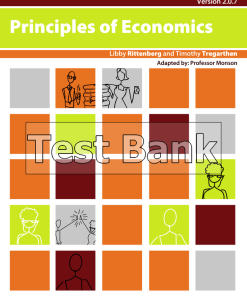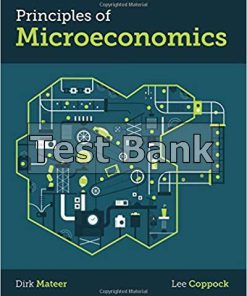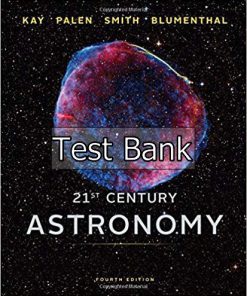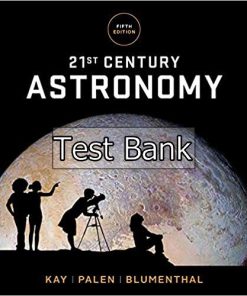Principles of microeconomics v 3.0 1st Edition Rittenberg Test Bank
$50.00 Original price was: $50.00.$26.50Current price is: $26.50.
Principles of microeconomics v 3.0 1st Edition Rittenberg Test Bank.
This is completed downloadable of Principles of microeconomics v 3.0 1st Edition Rittenberg Test Bank

Product Details:
- ISBN-10 : 1453383727
- ISBN-13 : 978-1453383728
- Author: Libby Rittenberg (Author), Timothy Tregarthen (Author)
If purchased from FlatWorld, the publisher, this version includes Online Access, Homework and a Print copy via a redeemable code shipped with the print book. In Principles of Microeconomics, the authors explore how political outcomes of events, such as Brexit and the election of Donald Trump, affect economic policies and economic outcomes. Throughout the last decade, economists have received the public’s attention, and the authors saw an opportunity to share economic principles and thinking in a way that emphasizes their relevance in today’s world.
Table of Content:
Chapter 1: Economics: The Study of Choice
- 1.1 Start Up: Economics in the News
- 1.2 Defining Economics
- 1.3 The Field of Economics
- 1.4 The Economists’ Tool Kit
- 1.5 Review and Practice
Chapter 2: Confronting Scarcity: Choices in Production
- 2.1 Start Up: An Attempt to Produce Safer Air Travel
- 2.2 Factors of Production
- 2.3 The Production Possibilities Curve
- 2.4 Applications of the Production Possibilities Model
- 2.5 Review and Practice
Chapter 3: Demand and Supply
- 3.1 Start Up: Crazy for Coffee
- 3.2 Demand
- 3.3 Supply
- 3.4 Demand, Supply, and Equilibrium
- 3.5 Review and Practice
Chapter 4: Applications of Demand and Supply
- 4.1 Start Up: A Composer Logs On
- 4.2 Putting Demand and Supply to Work
- 4.3 Government Intervention in Market Prices: Price Floors and Price Ceilings
- 4.4 The Market for Health-Care Services
- 4.5 Review and Practice
Chapter 5: Elasticity: A Measure of Response
- 5.1 Start Up: Raise Fares? Lower Fares? What’s a Public Transit Manager To Do?
- 5.2 The Price Elasticity of Demand
- 5.3 Responsiveness of Demand to Other Factors
- 5.4 Price Elasticity of Supply
- 5.5 Review and Practice
Chapter 6: Markets, Maximizers, and Efficiency
- 6.1 Start Up: A Drive in the Country
- 6.2 The Logic of Maximizing Behavior
- 6.3 Maximizing in the Marketplace
- 6.4 Market Failure
- 6.5 Review And Practice
Chapter 7: The Analysis of Consumer Choice
- 7.1 Start Up: A Day at the Grocery Store
- 7.2 The Concept of Utility
- 7.3 Utility Maximization and Demand
- 7.4 Indifference Curve Analysis: An Alternative Approach to Understanding Consumer Choice
- 7.5 Review and Practice
Chapter 8: Production and Cost
- 8.1 Start Up: Street Cleaning Around the World
- 8.2 Production Choices and Costs: The Short Run
- 8.3 Production Choices and Costs: The Long Run
- 8.4 Review and Practice
Chapter 9: Competitive Markets for Goods and Services
- 9.1 Start Up: Life on the Farm
- 9.2 Perfect Competition: A Model
- 9.3 Output Determination in the Short Run
- 9.4 Perfect Competition in the Long Run
- 9.5 Review and Practice
Chapter 10: Monopoly
- 10.1 Start Up: Surrounded by Monopolies
- 10.2 The Nature of Monopoly
- 10.3 The Monopoly Model
- 10.4 Assessing Monopoly
- 10.5 Review and Practice
Chapter 11: The World of Imperfect Competition
- 11.1 Start Up: The Excitement of Groupon: What Rivals Will It Face?
- 11.2 Monopolistic Competition: Competition Among Many
- 11.3 Oligopoly: Competition Among the Few
- 11.4 Extensions of Imperfect Competition: Advertising and Price Discrimination
- 11.5 Review and Practice
Chapter 12: Wages and Employment in Perfect Competition
- 12.1 Start Up: College Pays
- 12.2 The Demand for Labor
- 12.3 The Supply of Labor
- 12.4 Labor Markets at Work
- 12.5 Review and Practice
Chapter 13: Interest Rates and the Markets for Capital and Natural Resources
- 13.1 Start Up: Mars—Here We Come!
- 13.2 Time and Interest Rates
- 13.3 Interest Rates and Capital
- 13.4 Natural Resources and Conservation
- 13.5 Review and Practice
Chapter 14: Imperfectly Competitive Markets for Factors of Production
- 14.1 Start Up: Hockey Players Frozen Out
- 14.2 Price-Setting Buyers: The Case of Monopsony
- 14.3 Monopsony and the Minimum Wage
- 14.4 Price Setters on the Supply Side
- 14.5 Review and Practice
Chapter 15: Public Finance and Public Choice
- 15.1 Start Up: Where Your Tax Dollars Go
- 15.2 The Role of Government in a Market Economy
- 15.3 Financing Government
- 15.4 Choices in the Public Sector
- 15.5 Review and Practice
Chapter 16: Antitrust Policy and Business Regulation
- 16.1 Start Up: The Plastic War
- 16.2 Antitrust Laws and Their Interpretation
- 16.3 Antitrust and Competitiveness in a Global Economy
- 16.4 Regulation: Protecting People from the Market
- 16.5 Review and Practice
Chapter 17: International Trade
- 17.1 Start Up: Trade Winds
- 17.2 The Gains from Trade
- 17.3 Two-Way Trade
- 17.4 Restrictions on International Trade
- 17.5 Review and Practice
Chapter 18: The Economics of the Environment
- 18.1 Start Up: Environmental Headwinds
- 18.2 Maximizing the Net Benefits of Pollution
- 18.3 Alternatives in Pollution Control
- 18.4 Review and Practice
Chapter 19: Inequality, Poverty, and Discrimination
- 19.1 Start Up: Occupy Wall Street and the World
- 19.2 Income Inequality
- 19.3 The Economics of Poverty
- 19.4 The Economics of Discrimination
- 19.5 Review and Practice
Chapter 20: Macroeconomics: The Big Picture
- 20.1 Start Up: Economy Limps Along
- 20.2 Growth of Real GDP and Business Cycles
- 20.3 Price-Level Changes
- 20.4 Unemployment
- 20.5 Review and Practice
Chapter 21: Measuring Total Output and Income
- 21.1 Start Up: The Lockup
- 21.2 Measuring Total Output
- 21.3 Measuring Total Income
- 21.4 GDP and Economic Well-Being
- 21.5 Review and Practice
Chapter 22: Aggregate Demand and Aggregate Supply
- 22.1 Start Up: The Great Warning
- 22.2 Aggregate Demand
- 22.3 Aggregate Demand and Aggregate Supply: The Long Run and the Short Run
- 22.4 Recessionary and Inflationary Gaps and Long-Run Macroeconomic Equilibrium
- 22.5 Review and Practice
Chapter 23: Economic Growth
- 23.1 Start Up: How Important Is Economic Growth?
- 23.2 The Significance of Economic Growth
- 23.3 Growth and the Long-Run Aggregate Supply Curve
- 23.4 Determinants of Economic Growth
- 23.5 Review and Practice
Chapter 24: The Nature and Creation of Money
- 24.1 Start Up: How Many Macks Does It Cost?
- 24.2 What Is Money?
- 24.3 The Banking System and Money Creation
- 24.4 The Federal Reserve System
- 24.5 Review and Practice
Chapter 25: Financial Markets and the Economy
- 25.1 Start Up: Clamping Down on Money Growth
- 25.2 The Bond and Foreign Exchange Markets
- 25.3 Demand, Supply, and Equilibrium in the Money Market
- 25.4 Review and Practice
Chapter 26: Monetary Policy and the Fed
- 26.1 Start Up: The Fed’s Extraordinary Challenges in 2008
- 26.2 Monetary Policy in the United States
- 26.3 Problems and Controversies of Monetary Policy
- 26.4 Monetary Policy and the Equation of Exchange
- 26.5 Review and Practice
Chapter 27: Government and Fiscal Policy
- 27.1 Start Up: A Massive Stimulus
- 27.2 Government and the Economy
- 27.3 The Use of Fiscal Policy to Stabilize the Economy
- 27.4 Issues in Fiscal Policy
- 27.5 Review and Practice
Chapter 28: Consumption and the Aggregate Expenditures Model
- 28.1 Start Up: A Dismal Year for Retailers
- 28.2 Determining the Level of Consumption
- 28.3 The Aggregate Expenditures Model
- 28.4 Aggregate Expenditures and Aggregate Demand
- 28.5 Review and Practice
Chapter 29: Investment and Economic Activity
- 29.1 Start Up: Jittery Firms Slash Investment
- 29.2 The Role and Nature of Investment
- 29.3 Determinants of Investment
- 29.4 Investment and the Economy
- 29.5 Review and Practice
Chapter 30: Net Exports and International Finance
- 30.1 Start Up: Currency Crises Shake the World
- 30.2 The International Sector: An Introduction
- 30.3 International Finance
- 30.4 Exchange Rate Systems
- 30.5 Review and Practice
Chapter 31: Inflation and Unemployment
- 31.1 Start Up: The Inflation/Unemployment Conundrum
- 31.2 Relating Inflation and Unemployment
- 31.3 Explaining Inflation–Unemployment Relationships
- 31.4 Inflation and Unemployment in the Long Run
- 31.5 Review and Practice
Chapter 32: A Brief History of Macroeconomic Thought and Policy
- 32.1 Start Up: Three Revolutions in Macroeconomic Thought
- 32.2 The Great Depression and Keynesian Economics
- 32.3 Keynesian Economics in the 1960s and 1970s
- 32.4 Macroeconomics for the 21st Century
- 32.5 Review and Practice
Appendix A: Graphs in Economics
- A.1 How to Construct and Interpret Graphs
- A.2 Nonlinear Relationships and Graphs without Numbers
- A.3 Using Graphs and Charts to Show Values of Variables
Appendix B: Extensions of the Aggregate Expenditures Model
- B.1 The Algebra of Equilibrium
- B.2 The Aggregate Expenditures Model and Fiscal Policy
- B.3 Review and Practice
People Also Search:
principles of microeconomics v 3.0 rittenberg
principles of microeconomics v 3.0 1st edition rittenberg
principles of microeconomics v 3.0
principles of microeconomics v 3.0 1st edition
principles of microeconomics v 3.0 1st edition download scribd
principles of microeconomics v 3.0 1st edition testbank download pdf
Instant download after Payment is complete
You may also like…
Solutions Manual
Principles of Economics v2.0 1st Edition Rittenberg Test Bank
Solutions Manual
Solutions Manual
Solutions Manual
Legal Environment of Business V 1.0.3 1st Edition Mayer Test Bank




















